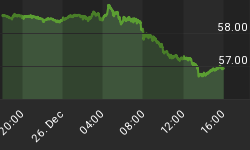What is Helicopter money? Can the Fed or ECB just drop money from the sky?
The answer is no, at least legally. As I have explained before, the Fed cannot provide capital, but it can provide liquidity.
Although central banks show little regard for the rules under which they operate, they have not resorted to "helicopter money" in any real sense. But they sure have created bubbles.

Popular Misconception
The above image (and hundreds of similar images), are often used to depict "helicopter money".
It's a popular misconception of what's really happening.
John Hussman discusses the above ideas in his latest weekly commentary Speculative Extremes and Historically-Informed Optimism.
Last week, market conditions joined the same tiny handful of extremes that defined the 1929, 1972, 1987, 2000 and 2007 market peaks. Still, the false signal near the start of 2014 (and lesser extremes before then), helpless in the face of single basis-point Treasury bill yields and uniform market internals, encourages a certain level of humility and flexibility.
The present yield-seeking speculative extreme is likely to be seen in hindsight as one of the three most reckless financial bubbles in U.S. history, on par with the 1929 and 2000 extremes. The present market cycle is likely to be completed by a collapse where a wholly run-of-the-mill outcome would be a decline of 40-55% in the S&P 500 Index.
One can object; didn't I incorrectly believe the same thing years ago, when similarly extreme conditions emerged with no consequence? Yes, I did. In mid-2014, I imposed conditions related to interest rates and market internals to avoid an excessive reliance on overvalued, overbought, overbullish syndromes. But be careful about dismissing historically reliable evidence of obscene valuations and speculative extremes on the basis of that difficult narrative. Both a century of history, and our own experience in full market cycles before the recent half-cycle advance, argue against complacency here.
As for the enticing concept of "helicopter money," my impression is that many observers are using the term with no understanding of what they are talking about. Despite the uninhibited imagery it evokes, "helicopter money" is nothing but a legislatively-approved fiscal stimulus package, financed by issuing bonds that are purchased by the central bank. Every country already does it, but the size is limited to the willingness of a legislature to pursue deficit spending. Central banks, on their own, can't "do" helicopter money without a spending package approved by the legislature. Well, at least the Federal Reserve can't under current law. To some extent, Europe and Japan can do it by purchasing low-quality bonds that subsequently default, but in that case, it's a private bailout rather than an economic stimulus. See, those central banks have resorted to buying lower-tier assets like asset-backed securities and corporate debt. If any of that debt defaults, the central bank has given a de facto bailout, with public funds, to the bondholder who otherwise would have taken a loss. So almost by definition, low-tier asset purchases by the ECB and Bank of Japan act as publicly-funded subsidies for bondholders, rather than ordinary citizens. My sense is that if the European and Japanese public had a better sense of this, they would tear down both central banks brick-by-brick.
As for the U.S., I'd actually be quite comfortable with a reasonable amount of "helicopter money" provided that the accompanying fiscal stimulus package was focused, not on consumption, but on productive investment at the public, private and individual level (infrastructure, investment and R&D tax credits, workforce training, education, and so forth). It's the absence of productive real investment, which since 2000 has slumped to a small fraction of its historical growth rate, along with the encouragement of rank yield-seeking speculation by the Fed, that has repeatedly injured the U.S. economy, and is likely to insult the economy with further crises before any durable lessons are learned.
Here and now, really the only factor that mitigates crash risk, and encourages us to refrain from pounding the tables about immediate market loss, is that some trend-following components in our measures of market internals have become constructive during the recent advance, though not enough - at least as yet - to shift their overall status. In the absence of stronger mitigating conditions, mirroring the late-2011 to mid-2014 period, the decision-making of investors should consider the breathtakingly negative outcomes that have generally followed similarly overvalued, overbought, overbullish extremes. In any event, don't allow your decision-making to be driven by "fear of missing out" at what is already one of the most extreme points of speculative overvaluation in history.
The current half-cycle market advance is remarkably long-in-the-tooth. There little basis for investment at these valuations - only speculation.
Helicopter Money for Public Investment
My only disagreement with Hussman in in regards to helicopter money for public investment.
The US has a debt problem and a spending problem. Instead, I would gladly cut war-mongering waste for more productive uses.
Yet, that alone is insufficient. We also need to scrap Davis Bacon and all prevailing wage laws to get the most bang for the buck. Federal and state projects are way too costly because of union rules.
Mario Draghi on QE for the People

Mario Draghi Answers Questions on Helicopters
Negative Multipliers
If QE and negative interest rates worked, we would not have seen the rise of Marine Le Pen in France or Beppe Grillo in Italy, Eurozone growth would not be anemic, Brexit would not have happened, and someone like Donald Trump never would have won the nomination.
All we have have to show for QE is another massive set of global financial asset bubbles.
For further discussion, please see Lacy Hunt on Negative Multiplier of Government Debt.
















